Compiled by Tom Lake, Hudson River Estuary Program Consulting Naturalist
Overview
These two weeks featured bird counts, in particular our Hudson Valley Christmas Bird Counts (CBC). These surveys produce much data that, when analyzed over time, reveal trends that note changes in range movement as well as species abundance and scarcity. These changes can reflect effects from human as well as climate impacts on their ecology.
Highlight of the Week
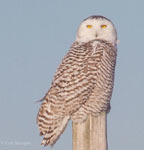 12/20 – Brooklyn, New York City: The bird was perfectly camouflaged in a most unfortunate way — an adult female snowy owl was surrounded by plastic garbage bags on the very brown grasslands at Floyd Bennett Field. The resemblance was uncanny. Everywhere I looked, the balled-up bags and their smudgy white color made for passable snowy owls. In the end, I counted just one real snowy owl. 12/20 – Brooklyn, New York City: The bird was perfectly camouflaged in a most unfortunate way — an adult female snowy owl was surrounded by plastic garbage bags on the very brown grasslands at Floyd Bennett Field. The resemblance was uncanny. Everywhere I looked, the balled-up bags and their smudgy white color made for passable snowy owls. In the end, I counted just one real snowy owl.
The experience reminded me of the famous Peppered Moth adaptation during the mid-19th century industrial revolution in England. Then, black soot and ash from burning coal darkened the bark of trees, favoring the survival of darker (melanistic) moths. The adaptation became a favored trait in terms of evolution providing camouflage from bird predation and could be genetically passed to their offspring. The first "snowy owl" I ever saw turned out to be a Clorox bleach bottle on a sand dune. Now, two decades later, could the snowy owls be imitating plastic bags? (Photo of snowy owl courtesy of Curt Morgan)
- Dave Taft
Natural History Entries
12/15 – Hudson Valley: In the monochrome mist of a late autumn and early winter day, any tiny suggestion of long, warm, and sunny days to come was welcome. The sun set one minute later today, 4:30 PM, for the first time since July 4. How best to spend my extra minute? I decided to watch and listen to the pair of adult bald eagles from nest NY62 as they soared and chortled overhead, perhaps aware that the breeding season was not far off.
- Tom Lake
12/15 – Ulster County, HRM 96-86: We held our 69th annual Ulster County Mohonk Lake/Ashokan Reservoir Audubon Christmas Bird Count. Fifty-two participants in fifteen field parties recorded a total of 14,497 individual birds, representing 81 species, plus one additional count-week species.
Diversity was four species above our current ten-year average of 77 species/year, six species shy of our all-time record high count of 87 species encountered last year. Total abundance was slightly above the ten-year average of 14,056 individuals, but well-below our record high 22,307 from 2017. No new species were added to the count composite, maintaining our historical total at 147 species.
Among the notable high counts, with previous high counts noted, were bufflehead (eight, four in 2007); red-tailed hawk (84, 80 in 2010); barred owl (nine, 7 in 2017); red-headed woodpecker (seven, three in 1984); red-bellied woodpecker (153, 141 in 2017); pileated woodpecker (40, 33 in 2017); and Carolina wren (121, 68 in 2014). The 194 eastern bluebirds we counted was just one shy of our all-time record high.
- Steve Chorvas
[The Christmas Bird Count, the nation’s longest running citizen-science effort, is held throughout the country at year’s end. It replaced the Victorian era “side-shoot,” in which guests chose up sides and then went out to shoot as many different bird and other animal species as they could on Christmas Day. In 1900, ornithologist Frank Chapman organized a group of friends to observe, count and share information about bird species without shooting them. The National Audubon Society, which Chapman helped organize, now sponsors this annual tradition. Each year, thousands of people go out to count and publish as many bird species as their group can in a sporting, competitive manor. The result has been the gathering of data regarding changes in bird populations and range over the years, including indications that the center of abundance for many has moved 200 miles north over the last 40 years. Rich Guthrie.]
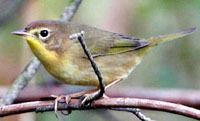 12/15 – Town of Poughkeepsie, HRM 76: Yesterday’s Ralph T. Waterman Bird Club Christmas Bird Count recorded a very unexpected bird, a common yellowthroat. Two of our most experienced birders, Carol and Ken Fredericks, had a clear, up-close, look of the warbler at Vassar Farm. The common yellowthroat is a seasonal resident in Dutchess County. According to The Birds of Dutchess County (DeOrsey and Butler), there have been four previous late-fall/winter records of common yellowthroat: Walter Claire Jr., December 5, 10, 1963; two in December 1970; and one in November 1980. (Photo of common yellowthroat courtesy of Deborah Tracy-Kral) 12/15 – Town of Poughkeepsie, HRM 76: Yesterday’s Ralph T. Waterman Bird Club Christmas Bird Count recorded a very unexpected bird, a common yellowthroat. Two of our most experienced birders, Carol and Ken Fredericks, had a clear, up-close, look of the warbler at Vassar Farm. The common yellowthroat is a seasonal resident in Dutchess County. According to The Birds of Dutchess County (DeOrsey and Butler), there have been four previous late-fall/winter records of common yellowthroat: Walter Claire Jr., December 5, 10, 1963; two in December 1970; and one in November 1980. (Photo of common yellowthroat courtesy of Deborah Tracy-Kral)
- Frank Margiotta (Ralph T. Waterman Bird Club)
12/15 – Orange County, HRM 67: The big pond at Camel Farm in Wurtsboro held well over 100 Canada geese. While I watched, another hundred joined them, and the sound level rose an octave. Then I heard a different call and spotted a broad ragged V of snow geese, a wavy line on the horizon, approaching from the south. As they neared, they split in two, with one half striking off to the east and the other half landing in the pond separate from the Canadas. In the even light of a foggy morning, the 40 snow geese glowed.
- Tom Lake
 12/15 – Orange County, HRM 63: During the E.A. Mearns Bird Club's annual Christmas Bird Count, Curt Goulding, Jeff Goulding, and I spotted a bat flying around in the early afternoon at Orange Lake (air temperature was 48 degrees Fahrenheit (F)). Our guess was that it might have been a little brown myotis. It seemed kind of late in the year for a bat to be out and about. 12/15 – Orange County, HRM 63: During the E.A. Mearns Bird Club's annual Christmas Bird Count, Curt Goulding, Jeff Goulding, and I spotted a bat flying around in the early afternoon at Orange Lake (air temperature was 48 degrees Fahrenheit (F)). Our guess was that it might have been a little brown myotis. It seemed kind of late in the year for a bat to be out and about.
For the CBC, nine teams counted 15,696 birds of 72 species with Canada Geese (1,784) the high number. Other notables included more black vultures (54) than turkey vultures (26), and a single, uncommon, red-breasted merganser. (Photo of black vultures courtesy of Terry Hardy)
- Ken McDermott
12/15 – Town of Warwick, HRM 47: There was very little open water at Liberty Marsh this morning, therefore no waterfowl. The show was in the air. I watched two male northern harriers, "gray ghosts", a football field apart, dipping, swaying, and teetering over the hummocks, showing off their incredible aerial dexterity. First one, then the other, would rise out of the swales and make slow glides over the marsh.
- Tom Lake
[Liberty Marsh’s 335 acres are part of the U.S. Fish and Wildlife Service’s Wallkill River National Wildlife Refuge complex near the headwaters of the Wallkill River. Tom Lake]
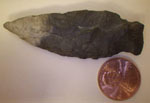 12/16 – Hoosick Falls to Albany, HRM 170-145: I remember one of my Dad's (Patrick Hynes) prized possessions: an Indian artifact. I never knew the exact provenience (original location) of the artifact, but I know my Dad lived and worked in the Hudson River Valley between the Capitol District and Hoosick Falls. With some investigation, including referencing a type collection and checking field guides, we concluded that the spear point was what archaeologists call an Orient Fishtail projectile point, and it had been fashioned from stone called Onondaga chert. (Photo of Orient Fishtail courtesy of Kevin Hynes) 12/16 – Hoosick Falls to Albany, HRM 170-145: I remember one of my Dad's (Patrick Hynes) prized possessions: an Indian artifact. I never knew the exact provenience (original location) of the artifact, but I know my Dad lived and worked in the Hudson River Valley between the Capitol District and Hoosick Falls. With some investigation, including referencing a type collection and checking field guides, we concluded that the spear point was what archaeologists call an Orient Fishtail projectile point, and it had been fashioned from stone called Onondaga chert. (Photo of Orient Fishtail courtesy of Kevin Hynes)
- Kevin Hynes
[The Orient is a northeast Indian cultural phase that receives its name from its type site on the north fork of eastern Long Island. The phase is known for its innovative early “ceramics,” bowls made from soapstone or steatite, a rather easily carved metamorphic rock. Orient Fishtail points are found in contexts that radio-carbon date between 3,200 and 2,700 years ago, well in advance of bow-and-arrow technology in the Northeast. Archaeologists believe that these stone points were likely used as javelin tips for a spear-thrower called an atlatl. It is quite possible that the maker of this projectile point was an ancestral Mohican Indian, since the general locale where it was found would later become Mohican homeland. Finds like these are timeless. Their value lies in their authentication of our Hudson River Valley's antiquity. Tom Lake]
12/17 – Verplanck, HRM 40.5: Sea turtles are rare in the lower Hudson River estuary. Last July, the Almanac reported a stranded Kemp's Ridley sea turtle (Lepidochelys kempii) on the beach at Rockaway Peninsula. The turtle was rescued and released. At the time, we mentioned an earlier occurrence (August 1995) of a Kemp's Ridley sea turtle at Spuyten Duyvil, off the Harlem River, that died from a fractured carapace, the result from being struck by a boat propeller. However, there was a third and more recent Kemp's Ridley (August 2010) that we neglected to mention. This one was found on the beach at Verplanck (HRM 40.5). The Riverhead Foundation for Marine Research and Preservation responded and found that, like the 1995 sea turtle, this one had also died from a fractured carapace, the result from being struck by a boat propeller.
- Tom Lake
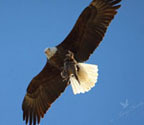 12/18 – Eastern Dutchess County: I watched an adult bald eagle carry a freshly-caught ring-necked pheasant out of a hunting preserve where they are stocked. This was not a rare sighting. It is not uncommon to see wintering golden eagles patrolling the area looking for stray pheasants. (Photo of ring-necked pheasant with Bald Eagle courtesy of Terry Hardy) 12/18 – Eastern Dutchess County: I watched an adult bald eagle carry a freshly-caught ring-necked pheasant out of a hunting preserve where they are stocked. This was not a rare sighting. It is not uncommon to see wintering golden eagles patrolling the area looking for stray pheasants. (Photo of ring-necked pheasant with Bald Eagle courtesy of Terry Hardy)
- Terry Hardy
[The ring-necked pheasant (Phasianus colchicus) is native to Asia but has been extensively introduced into North America and raised as a game bird. Seasonal holdovers from hunt club introductions find it difficult to survive in the presence of robust coyote and fox populations in the Hudson Valley. Tom Lake]
12/19 – Kingston, HRM 92: Large congregations of gulls in winter are always an opportunity to find one that is unexpected. Searching more than a hundred gulls with binoculars on the beach at Kingston Point was tedious work. I found myself parsing out discreet groups of ring-billed gulls, one group at a time, eliminating them as prospects for hiding a winter gull, and then moving on to another. Halfway through my survey, an immature bald eagle flew over the gulls, not more than 50 feet overhead. Pandemonium ensued! It took several minutes for the scattered gulls to come back to their stretch of the beach, but by then I had to begin all over again. Midway through the last dozen gulls, a single white-winged gull, and Iceland gull, emerged from behind them. Iceland gulls (Larus glaucoides) breed in the Arctic regions of Canada and winter from Labrador south to New England and west across the Great Lakes.
- Tom Lake
[When we talk of “white winged gulls” in the eastern United States, we are referring to Iceland and glaucous gulls. Adult ivory gulls are pure white and incredibly beautiful but are uncommon to rare in the watershed. Curt McDermott]
12/19 – Esopus Meadows, HRM 87: The new ice, only thick enough to hold a ring-billed gull, extended about 100 yards offshore. A large raft of common mergansers, both drakes and hens, bobbed in the lee of the Esopus Meadows Lighthouse. A smaller raft of buffleheads was diving a short distance away. An immature bald eagle sat perched in a hardwood along the beach not more than a few wing-beats from a meal of duck, if it so chose. Since it was an immature, not an adult, the eagle looked like a prince, not a king, holding court.
- Tom Lake
12/19 – Stony Point, HRM 40: In mid-afternoon, I counted 16 canvasbacks near the boat docks on the Hudson River across from Riverfront Park.
- Elizabeth Jamison
12/20 – Saratoga County: We had an unusual day doing our sector of the Saratoga Christmas Bird Count. Numbers were down overall, but we had a few surprising birds including two savannah sparrows, a northern pintail, a kestrel (actually 8 feet outside our sector!), and the bird-of- the-day, a male common yellowthroat, that we "pished" up out of a small marshy area.
- Steve Messick, Jackson Messick (Hudson-Mohawk Bird Club)
["Pishing," a soft vocalization, is a common tool used by birders to attract a variety of birds from songbirds to raptors. The common belief is that birds are attracted to the sound by their curiosity. Tom Lake]
12/21 – Albany, HRM 145: The air temperature reached 61 degrees F today, tying the record high for the date.
- National Weather Service
12/21 – Wappinger Creek, HRM 67.5: A driving rain and a heavy fog – the essence of a Scottish moor – lay over the 1.6-mile reach of the tidewater creek. Rare peeks in the gloom revealed a half-dozen drake hooded mergansers. At high tide, aided by two-inches of rain, Hunter's Brook, a tributary, had spilled over its rock-walled banks. Elsewhere, the creek had risen into the flood plain.
- Tom Lake, B.J. Jackson
12/21 - Dutchess County: The air temperature reached 63 degrees F today, tying the record high for the date.
- National Weather Service
12/21 - Beacon, HRM 61: Winter arrived at 5:23 PM. It was ironic that record-tying warmth would occur on the Winter Solstice.
- Tom Lake
[The Winter Solstice is an astronomical phenomenon marking the day with the shortest period of daylight and the longest night of the year. The winter solstice occurs at the moment when the Earth's tilt away from the sun is at a maximum (23.5 degrees relative to its orbit).
At New York, sunset today was 4:32 PM; sunrise tomorrow will be 7:17 AM; sunset tomorrow will be 4:32 PM. That will give us 14 hours and 45 minutes of night leading into tomorrow, and then 9 hours and 15 minutes of daylight – a long night and a short day. Tom Lake]
12/21 – Brooklyn, New York City: There were no snowy owls anywhere to be found at Floyd Bennett Field today. I had to settle for watching a beautiful male kestrel nervously tail-bobbing and pouncing on some unseen rodents in the very wet, nearby grasslands.
- Dave Taft
*** FISH OF THE WEEK ***
With winter here and much of the watershed’s ponds, creeks, lakes, and rivers iced-over, some of us are going through fish withdrawal. As a coping device, until fully open water returns in March, we will have a “Fish of the Week” feature.
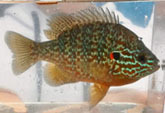 12/22 – Hudson River Watershed: This week’s choice was the pumpkinseed (Lepomis gibbosus). Ichthyologist C. Lavett Smith calls the pumpkinseed, “The most abundant and widespread species of sunfish in New York State” (The Inland Fishes of New York State, 1985). Pumpkinseed are one of thirteen species of sunfish (Centrarchidae) found in the Hudson River watershed and one of five that are native species. Two other sunfishes, largemouth bass and black crappie, appear to have been native in Lake George, a water body closely adjacent to the watershed. 12/22 – Hudson River Watershed: This week’s choice was the pumpkinseed (Lepomis gibbosus). Ichthyologist C. Lavett Smith calls the pumpkinseed, “The most abundant and widespread species of sunfish in New York State” (The Inland Fishes of New York State, 1985). Pumpkinseed are one of thirteen species of sunfish (Centrarchidae) found in the Hudson River watershed and one of five that are native species. Two other sunfishes, largemouth bass and black crappie, appear to have been native in Lake George, a water body closely adjacent to the watershed.
Pumpkinseed are the quintessential "panfish." Most are palm-size, less than ten-inches-long. Among freshwater fishes, few are more colorful than the male pumpkinseed. Most sport color varieties of orange, green, yellow, and blue, with red tabs on their opercle and turquoise piping on their head. (Photo of pumpkinseed courtesy of Tom Lake)
- Tom Lake
12/22 – Town of Bethlehem, HRM 141: Our recent sidebar citing naturalist Jim Rod's reference to common mergansers as “eagle food," prompted me to an eagle performance at Henry Hudson Park in Bethlehem. The adult pair from a nest that is visible from the park, tag-teamed a hen merganser just off shore. Each time the tag-teaming pair came at her, the merganser dropped underwater in a dive. The duck made no attempt to move away, but simply dropped straight down at each attempt and then popped right up in the same place. After 15 minutes, the eagles gave up. One flew over to the nest and the other perched in a tree right overhead vocally expressing what may have been frustration. The merganser stretched up, flapped her wings, and then moved off seemingly unruffled.
- Warren LeGere
12/22 – Rensselaer County: Eight teams conducted our 53rd annual Southern Rensselaer County Christmas Bird Count surveying the streets, fields, and forests. High counts were the expected Canada geese, American crow, and European starling. There was not much variety in waterfowl. Snyder's Lake, that often has a diverse group, this year hosted just a single drake lesser scaup. Despite the anticipated winter finch irruption, we found only pine siskins. With no snow in the fields, we found no horned larks or snow buntings. The best bird of the day was a golden eagle seen in company with several bald eagles, soaring over Poestenkill farm fields.
- Naomi Lloyd (Hudson-Mohawk Bird Club)
12/23 – Milan, HRM 90: I spotted eleven very vocal common ravens in three groups circling “kettle-like” overhead in midday as they flew northwest toward Catskill. Higher and farther away were three other large black birds at a distance that made them difficult to identify.
- Frank Margiotta (Ralph T. Waterman Bird Club)
12/23 – Ulster Park, HRM 89: This afternoon, I found a raft of common goldeneyes – I counted 50 – drifting downriver in the ebb tide just south of Scenic Hudson’s High Banks Preserve.
- Peter Relson
12/23 – Putnam County, HRM 54: We were in town ready to enter a restaurant near the Cold Spring train station when we saw three black vultures on a nearby rooftop. Apparently, they didn't get the memo about the season of peace because two of them started squabbling. We were amazed at the conflict that featured a lot of loud hissing. The commotion attracted a small crowd of observers. After a while, the two aggressive vultures jumped over to another roof top, and the disagreement ceased.
- Pat Joel
12/23 – Rockland County, HRM 33: The coming breeding season looks promising for bald eagle nest NY336. Today's visit found an adult sitting in the nest – a good sign. I spotted another adult not far away perched on the north end of the Lake Deforest causeway. There was an immature sitting on the south end of the causeway as well.
- Chris Galligan
12/23 – Manhattan, HRM 8: While driving north early this morning on the Henry Hudson Parkway, just south of the Cloisters, I spotted a bald eagle soaring overhead on the inland side of the parkway. The adult eagle flew east-to-west toward the Hudson River. This may have been an eagle in migration; crossing New York City is a common New England to New Jersey route for wintering birds.
- Leah Caro
12/23 – Manhattan, HRM 7.5: Our bird survey of Central Park today documented 39 species. Notable among them were Canada geese (400), ruddy ducks (122), northern shovelers (66), American kestrels (two; male and female), and a female peregrine falcon. The great horned owl, previously reported, was still there in mid-park.
- Robert DeCandido, Deborah Allen
12/24 – Rockland County, HRM 33: I counted 17 black vultures soaring and drifting south over Congers Lake, another example of the growing presence of black vultures in the Hudson Valley. Just to the north, an immature bald eagle followed them.
- Chris Galligan
12/25 – Washington County, HRM 197: On Christmas Day, I came upon a barred owl on West Road in Argyle.
- Scott Varney (Hudson-Mohawk Bird Club)
 12/25 – Galeville, HRM 74: I had a very rewarding Christmas Day visit to the Shawangunks Grasslands National Wildlife Refuge. I counted no fewer than ten northern harriers and at least two were males, "gray ghosts.” At 4:20 PM (right on time), the short-eared owls came out. I counted three from my vantage point near the north blind. (Photo of northern harrier courtesy of Debbie Quick) 12/25 – Galeville, HRM 74: I had a very rewarding Christmas Day visit to the Shawangunks Grasslands National Wildlife Refuge. I counted no fewer than ten northern harriers and at least two were males, "gray ghosts.” At 4:20 PM (right on time), the short-eared owls came out. I counted three from my vantage point near the north blind. (Photo of northern harrier courtesy of Debbie Quick)
- Peter Relson
12/25 – Manhattan, HRM 7.5: Our Christmas Day bird survey of Central Park documented 37 species. Notable among them were Canada geese (250), ruddy ducks (150), northern shovelers (20), American kestrel (one male), peregrine falcons (an adult pair perched at the Reservoir as well as two others), a pied-billed grebe, a barred owl, and two northern saw-whet owls.
- Robert DeCandido, Deb Allen
12/26 – Schuylerville, HRM 186: In an effort to work off Christmas calories, I hiked the trails at Hudson Crossing Park and documented 19 bird species. Highlights of the day included three golden-crowned kinglets, a white-throated sparrow feeding on wild grapes, and an immature bald eagle. Other notables included both hooded and common mergansers, common goldeneye, and a greater black-backed gull.
- Scott Varney (Hudson-Mohawk Bird Club)
12/26 – Norrie Point, HRM 85: Two hours into the ebb tide at midday, from the back deck of the Norrie Point Environmental Education Center, we spotted a white-winged scoter swimming with common mergansers just off the north point of Esopus Island.
- Chet Vincent, Susan Joseph (Ralph T. Waterman Bird Club)
12/27 – Albany County, HRM 148: I looked out my window and noticed two huge birds perched in a tree at the edge of our woods. A red-tailed hawk and a great horned owl were having a territorial showdown. The great horned owls nest near there – I often see and hear them – and the hawks soar and hunt for the many rabbits in the area.
The hawk was perched about three-feet above the owl and kept "bobbing"; the owl just watched. After five minutes of posturing, the hawk jumped down to the owl's branch. The owl charged the hawk, talons first, and a chase through the woods was on. The owl was on the hawk's tail for as long as I could see them before they melted into the forest.
- Kristin Clemmy
12/28 – Schaghticoke, HRM 169: While scouting for the upcoming Troy Christmas Bird Count, we found a barred owl and a single snow goose among several hundred Canada geese on Fisherman's Lane. The three species were good enough for our Count Week!
- Naomi Lloyd (Hudson-Mohawk Bird Club)
[Count week is defined as birds documented from three days before to three days after the official count day (in this instance, a Christmas Bird Count). Count-week birds serve as a place holder for that species on the checklist for a given count. National Audubon]
Winter 2018 Natural History Programs
TBA
Hudson River Miles
The Hudson is measured north from Hudson River Mile 0 at the Battery at the southern tip of Manhattan. The George Washington Bridge is at HRM 12, the Tappan Zee 28, Bear Mountain 47, Beacon-Newburgh 62, Mid-Hudson 75, Kingston-Rhinecliff 95, Rip Van Winkle 114, and the Federal Dam at Troy, the head of tidewater, at 153. The tidal section of the Hudson constitutes a bit less than half the total distance – 315 miles – from Lake Tear of the Clouds to the Battery. Entries from points east and west in the watershed reference the corresponding river mile on the mainstem.
To Contribute Your Observations or to Subscribe
The Hudson River Almanac is compiled and edited by Tom Lake and emailed weekly by DEC's Hudson River Estuary Program. Share your observations by e-mailing them to trlake7@aol.com.
To subscribe to the Almanac (or to unsubscribe), use the links on DEC's Hudson River Almanac or DEC Delivers web pages.
Discover New York State Conservationist - the award-winning, advertisement-free magazine focusing on New York State's great outdoors and natural resources. Conservationist features stunning photography, informative articles and around-the-state coverage. Visit the Conservationist webpage for more information.
Useful Links
National Oceanic and Atmospheric Administration online tide and tidal current predictions are invaluable when planning Hudson River field trips.
For real-time information on Hudson River tides, weather and water conditions from sixteen monitoring stations, visit the Hudson River Environmental Conditions Observing System website.
DEC's Smartphone app for iPhone and Android is now available at: New York Fishing, Hunting & Wildlife App.
Adventure NY
Under Governor Cuomo's Adventure NY initiative, DEC is making strategic investments to expand access to healthy, active outdoor recreation, connect more New Yorkers and visitors to nature and the outdoors, protect natural resources, and boost local economies. This initiative will support the completion of more than 75 projects over the next three years, ranging from improvements to youth camps and environmental education centers to new boat launches, duck blinds, and hiking trails. Read more about the Adventure NY initiative. For more information on planning an outdoor adventure in New York State, visit DEC's website at http://www.dec.ny.gov/outdoor.
Information about the Hudson River Estuary Program is available on DEC's website at http://www.dec.ny.gov/lands/4920.html.
Copies of past issues of the Hudson River Almanac, Volumes II-VIII, are available for purchase from the publisher, Purple Mountain Press, (800) 325-2665, or email purple@catskill.net
|


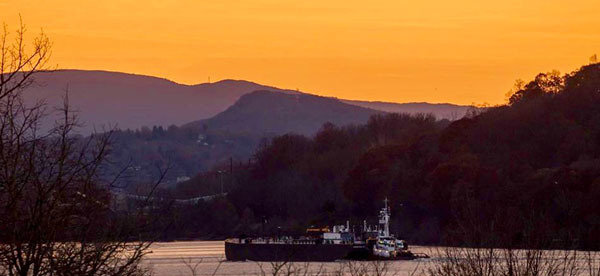 Hudson River Almanac
Hudson River Almanac 12/20 – Brooklyn, New York City: The bird was perfectly camouflaged in a most unfortunate way — an adult female snowy owl was surrounded by plastic garbage bags on the very brown grasslands at Floyd Bennett Field. The resemblance was uncanny. Everywhere I looked, the balled-up bags and their smudgy white color made for passable snowy owls. In the end, I counted just one real snowy owl.
12/20 – Brooklyn, New York City: The bird was perfectly camouflaged in a most unfortunate way — an adult female snowy owl was surrounded by plastic garbage bags on the very brown grasslands at Floyd Bennett Field. The resemblance was uncanny. Everywhere I looked, the balled-up bags and their smudgy white color made for passable snowy owls. In the end, I counted just one real snowy owl. 12/15 – Town of Poughkeepsie, HRM 76: Yesterday’s Ralph T. Waterman Bird Club Christmas Bird Count recorded a very unexpected bird, a common yellowthroat. Two of our most experienced birders, Carol and Ken Fredericks, had a clear, up-close, look of the warbler at Vassar Farm. The common yellowthroat is a seasonal resident in Dutchess County. According to The Birds of Dutchess County (DeOrsey and Butler), there have been four previous late-fall/winter records of common yellowthroat: Walter Claire Jr., December 5, 10, 1963; two in December 1970; and one in November 1980. (Photo of common yellowthroat courtesy of Deborah Tracy-Kral)
12/15 – Town of Poughkeepsie, HRM 76: Yesterday’s Ralph T. Waterman Bird Club Christmas Bird Count recorded a very unexpected bird, a common yellowthroat. Two of our most experienced birders, Carol and Ken Fredericks, had a clear, up-close, look of the warbler at Vassar Farm. The common yellowthroat is a seasonal resident in Dutchess County. According to The Birds of Dutchess County (DeOrsey and Butler), there have been four previous late-fall/winter records of common yellowthroat: Walter Claire Jr., December 5, 10, 1963; two in December 1970; and one in November 1980. (Photo of common yellowthroat courtesy of Deborah Tracy-Kral) 12/15 – Orange County, HRM 63: During the E.A. Mearns Bird Club's annual Christmas Bird Count, Curt Goulding, Jeff Goulding, and I spotted a bat flying around in the early afternoon at Orange Lake (air temperature was 48 degrees Fahrenheit (F)). Our guess was that it might have been a little brown myotis. It seemed kind of late in the year for a bat to be out and about.
12/15 – Orange County, HRM 63: During the E.A. Mearns Bird Club's annual Christmas Bird Count, Curt Goulding, Jeff Goulding, and I spotted a bat flying around in the early afternoon at Orange Lake (air temperature was 48 degrees Fahrenheit (F)). Our guess was that it might have been a little brown myotis. It seemed kind of late in the year for a bat to be out and about. 12/16 – Hoosick Falls to Albany, HRM 170-145: I remember one of my Dad's (Patrick Hynes) prized possessions: an Indian artifact. I never knew the exact provenience (original location) of the artifact, but I know my Dad lived and worked in the Hudson River Valley between the Capitol District and Hoosick Falls. With some investigation, including referencing a type collection and checking field guides, we concluded that the spear point was what archaeologists call an Orient Fishtail projectile point, and it had been fashioned from stone called Onondaga chert. (Photo of Orient Fishtail courtesy of Kevin Hynes)
12/16 – Hoosick Falls to Albany, HRM 170-145: I remember one of my Dad's (Patrick Hynes) prized possessions: an Indian artifact. I never knew the exact provenience (original location) of the artifact, but I know my Dad lived and worked in the Hudson River Valley between the Capitol District and Hoosick Falls. With some investigation, including referencing a type collection and checking field guides, we concluded that the spear point was what archaeologists call an Orient Fishtail projectile point, and it had been fashioned from stone called Onondaga chert. (Photo of Orient Fishtail courtesy of Kevin Hynes) 12/18 – Eastern Dutchess County: I watched an adult bald eagle carry a freshly-caught ring-necked pheasant out of a hunting preserve where they are stocked. This was not a rare sighting. It is not uncommon to see wintering golden eagles patrolling the area looking for stray pheasants. (Photo of ring-necked pheasant with Bald Eagle courtesy of Terry Hardy)
12/18 – Eastern Dutchess County: I watched an adult bald eagle carry a freshly-caught ring-necked pheasant out of a hunting preserve where they are stocked. This was not a rare sighting. It is not uncommon to see wintering golden eagles patrolling the area looking for stray pheasants. (Photo of ring-necked pheasant with Bald Eagle courtesy of Terry Hardy) 12/22 – Hudson River Watershed: This week’s choice was the pumpkinseed (Lepomis gibbosus). Ichthyologist C. Lavett Smith calls the pumpkinseed, “The most abundant and widespread species of sunfish in New York State” (The Inland Fishes of New York State, 1985). Pumpkinseed are one of thirteen species of sunfish (Centrarchidae) found in the Hudson River watershed and one of five that are native species. Two other sunfishes, largemouth bass and black crappie, appear to have been native in Lake George, a water body closely adjacent to the watershed.
12/22 – Hudson River Watershed: This week’s choice was the pumpkinseed (Lepomis gibbosus). Ichthyologist C. Lavett Smith calls the pumpkinseed, “The most abundant and widespread species of sunfish in New York State” (The Inland Fishes of New York State, 1985). Pumpkinseed are one of thirteen species of sunfish (Centrarchidae) found in the Hudson River watershed and one of five that are native species. Two other sunfishes, largemouth bass and black crappie, appear to have been native in Lake George, a water body closely adjacent to the watershed.  12/25 – Galeville, HRM 74: I had a very rewarding Christmas Day visit to the Shawangunks Grasslands National Wildlife Refuge. I counted no fewer than ten northern harriers and at least two were males, "gray ghosts.” At 4:20 PM (right on time), the short-eared owls came out. I counted three from my vantage point near the north blind. (Photo of northern harrier courtesy of Debbie Quick)
12/25 – Galeville, HRM 74: I had a very rewarding Christmas Day visit to the Shawangunks Grasslands National Wildlife Refuge. I counted no fewer than ten northern harriers and at least two were males, "gray ghosts.” At 4:20 PM (right on time), the short-eared owls came out. I counted three from my vantage point near the north blind. (Photo of northern harrier courtesy of Debbie Quick)